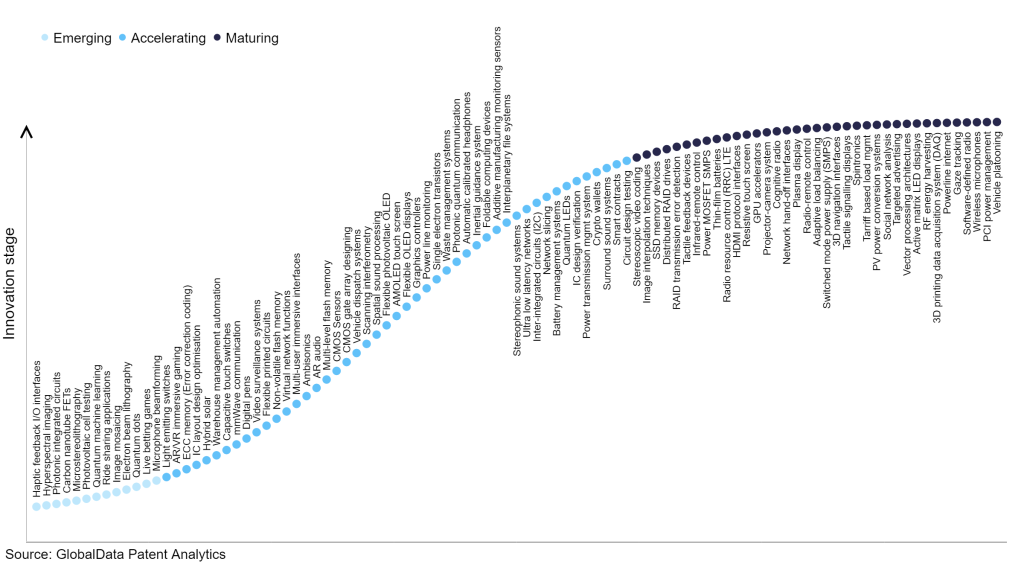The technology industry continues to be a hotbed of innovation, with activity driven by the need for faster and more accurate computational capabilities in handling complex datasets, continuous progress in quantum hardware and algorithms, and the potential for quantum machine learning to provide significant advancements in various industries, such as drug discovery and optimisation problems. This has resulted in growing importance of technologies such as quantum algorithms, quantum hardware, and quantum data encoding techniques. These technologies enable the development of highly advanced and intelligent learning models that can process vast amounts of data at an unprecedented speed. In the last three years alone, there have been over 3.6 million patents filed and granted in the technology industry, according to GlobalData’s report on Technology Innovation: Quantum machine learning. Buy the report here.
However, not all innovations are equal and nor do they follow a constant upward trend. Instead, their evolution takes the form of an S-shaped curve that reflects their typical lifecycle from early emergence to accelerating adoption, before finally stabilising and reaching maturity.
Identifying where a particular innovation is on this journey, especially those that are in the emerging and accelerating stages, is essential for understanding their current level of adoption and the likely future trajectory and impact they will have.
300+ innovations will shape the technology industry
According to GlobalData’s Technology Foresights, which plots the S-curve for the technology industry using innovation intensity models built on over 2.5 million patents, there are 300+ innovation areas that will shape the future of the industry.
Within the emerging innovation stage, microphone beamforming, live betting games, and quantum dots are disruptive technologies that are in the early stages of application and should be tracked closely. Circuit design testing, smart contracts, and surround sound systems are some of the accelerating innovation areas, where adoption has been steadily increasing. Among maturing innovation areas are vehicle platooning and peripheral component interconnect (PCI) power management, which are now well established in the industry.
Innovation S-curve for the technology industry

Quantum machine learning is a key innovation area in technology
Quantum machine learning is a research area focused on leveraging quantum computing to develop advanced algorithms and models for machine learning. Combining the principles of quantum computing and machine learning, it enables the creation of more powerful models and algorithms compared to classical approaches. This enables the exploration of intricate data, uncovering novel insights, and enhancing decision-making processes.
GlobalData’s analysis also uncovers the companies at the forefront of each innovation area and assesses the potential reach and impact of their patenting activity across different applications and geographies. According to GlobalData, there are 20+ companies, spanning technology vendors, established technology companies, and up-and-coming start-ups engaged in the development and application of quantum machine learning.
Key players in quantum machine learning – a disruptive innovation in the technology industry
‘Application diversity’ measures the number of different applications identified for each relevant patent and broadly splits companies into either ‘niche’ or ‘diversified’ innovators.
‘Geographic reach’ refers to the number of different countries each relevant patent is registered in and reflects the breadth of geographic application intended, ranging from ‘global’ to ‘local’.
Patent volumes related to quantum machine learning
Source: GlobalData Patent Analytics
Alphabet is a leading patent filer in the field of quantum machine learning. One of the company’s patents describes an apparatus and methods used for eliminating qubit leakage. The apparatus includes qubits that can occupy multiple levels, including computational and non-computational levels, with transitions controlled by a corresponding frequency. Couplers connect the qubits to a cavity, which is further coupled to an external environment. A frequency controller adjusts the qubit frequency relative to the cavity frequency to transfer the population from non-computational levels to the cavity, effectively removing the leakage.
Other prominent patent filers in the space include International Business Machines (IBM) and D-Wave Quantum.
By geographic reach, Turck duotec leads the pack, followed by ELMOS Semiconductor and Northrop Grumman. In terms of application diversity, MITRE holds the top position, followed by Atos and Lam Research.
Quantum machine learning algorithms and models can process and analyse complex data more efficiently and accurately than classical approaches. This opens new possibilities for solving intricate problems, optimising decision-making processes, and discovering valuable insights that were previously inaccessible. Quantum machine learning has the potential to drive advancements in various fields, including drug discovery, financial modelling, and optimisation problems.
To further understand the key themes and technologies disrupting the technology industry, access GlobalData’s latest thematic research report on Technology.
Data Insights
From

The gold standard of business intelligence.
Blending expert knowledge with cutting-edge technology, GlobalData’s unrivalled proprietary data will enable you to decode what’s happening in your market. You can make better informed decisions and gain a future-proof advantage over your competitors.







